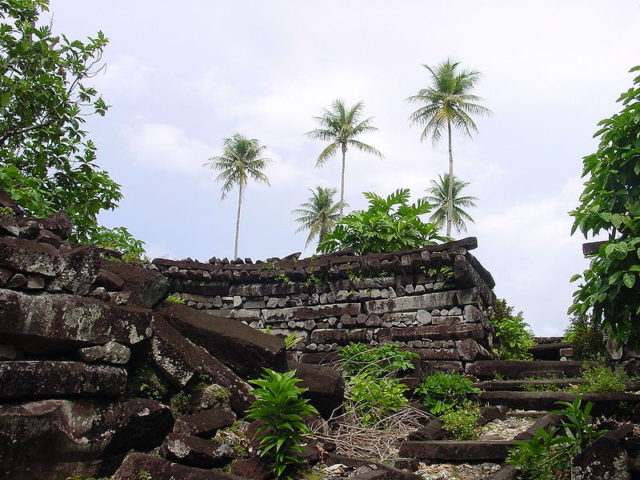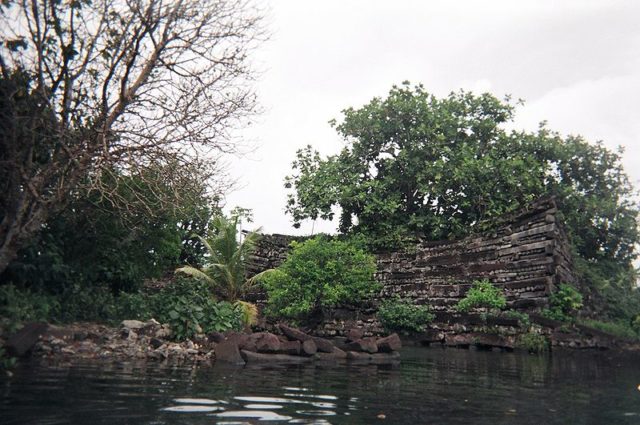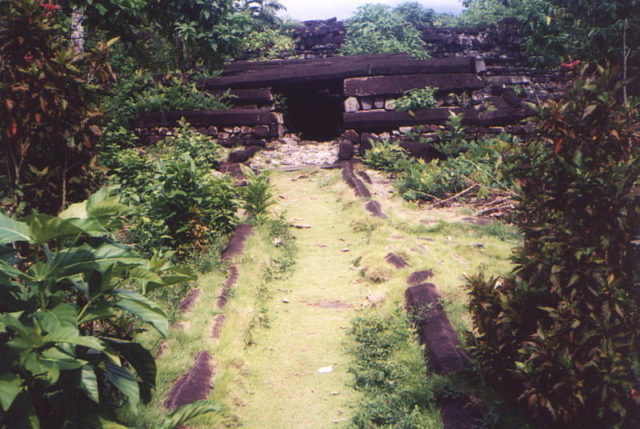New dating on the stone buildings of Nan Madol proposes that the ancient coral reef capital located in the Pacific Ocean was the earliest of the islands to be ruled by a single chief.
The finding makes Nan Madol an important locale for examining how ancient societies developed from simple societies to more complicated ones. This was stated by archaeologist Mark D. McCoy, from Southern Methodist University, located in Dallas, Texas. McCoy guided the discovery team.

The discovery was uncovered as part of a National Geographic expedition to analyze the massive tomb that is said to belong to the first chief of the island of Pohnpei.
McCoy used the process of uranium-series dating to determine that the tomb was the first of its kind when created, making this the first burial site of a massive scale on the Pacific islands.
The finding enables archaeologists to examine more precisely how societies are able to transform to more colonial and hierarchical systems, as stated by McCoy, who is a specialist in landscape archaeology and massive architecture, and ideology in the Pacific Islands.
He has also said that the type of society we find today was not a recent phenomenon, or even something seen 100 years ago. It has roots in a pre-modern era like Nan Madol where you have a chief. These islanders fabricated a new type of society – a socially-creative accomplishment. The idea of having chiefs, of someone being in charge, isn’t a new thing but it’s an important development. We all know tribes and bands predate chiefs and states but it’s not exactly a straight line. When we look at these intermediate stages, we get an insight into that social development.
The study is the first to use uranium-thorium series dating, a more precise process than previously-used radiocarbon dating. It was deployed to estimate the age of the stone structures that created the famous site of Nan Madol (it’s pronounced Nehn Mud-DOLL), the former capital of the islands of Pohnpei.

It’s said by the archaeologists that this case is special because the civilization at Nan Madol developed in complete isolation; there are multiple lines of proof, including oral histories, to support the theory. Since it’s an island, they’re able to have more specific natural resources to learn about the population with more precision. This is more difficult where people are on a continent and are all inter-connected.
At first, Nan Madol was thought to have been established in 1300 AD. McCoy’s team was able to narrow that down to a 20-year window more than 100 years earlier – from 1180 to 1200 AD.
The discovery pushes back to an even earlier time, to the formation of the powerful dynasty of Saudeleur chiefs who declared authority over the island society for over 1,000 years. The First chief was buried in Pohnpei tomb by 1200 AD.
The ancient city of Nan Madol was made atop of a coral reef and was uninhabited for centuries. It’s located inside the northwestern Pacific on the island of Pohnpei. It’s accessible by a 10-hour flight from Hawaii that’s interspersed with short hops from atoll to atoll. This includes a stop at a U.S. military installation. Nan Madol is one of the largest archaeological sites located in Micronesia, a group of islands in the Caroline Archipelago of Oceania.
The uranium dating has indicated that by 1180 large stones were being moved from a volcanic plug on the opposite side of the island for the construction of a tomb. By the year 1200, the burial vault had its first inhabitant, the island’s chief.
Construction of the massive buildings followed over many centuries on other islands that were not in the Saudeleur Dynasty across Oceania.
McCoy is an associate professor in the SMU Department of Anthropology, and his group reported their discovery in the journal Quaternary Research. Theirs was the earliest direct proof of massive building at the archaeological location of Nan Madol, identified using 230 Th/U coral dating and geochemical architectural stone. The co-authors included Richard Hemi from the University of Otago, New Zealand, Helen A. Alderson of University of Cambridge, Xi’an Jiaotong from the University of China, and R. Lawrence Edwards from the University of Minnesota.

Pohpei Island is much bigger than its neighboring islands at 128 square miles in area. This makes it around the size of Columbia. There is an inactive volcano located on the island that hasn’t erupted in at least one million years.
Now a part of the 607 island nation of the Federate States of Micronesia, Pohnpei Island, and its close islands, have a population of 34,000 people.
How Nan Madol was built is still an engineering mystery, much like Egypt’s Pyramids. McCoy stated that its construction is a fair comparison to the Pyramids and like the Pyramids, it was just a really good place to put a person who died.
He said it’s important to document such things because this architectural wonder shows that, independently, Egypt and other groups of people put effort into building monuments. The archaeologists think that it’s associated with the invention of a new type of society, and a new type of chiefdom that ruled the hole island. Nan Madol, unlike Egypt and its pyramids, was a much more recent addition to the huge story of human prehistory. The Romans and Egyptians had come and gone, but Pohnpei is recent enough that archaeologists still have the oral histories of the descendants of the people who created Nan Madol. This is evidence that you don’t have anywhere else.
The massive city was made of coral and stone. Pohnpei was first settled in 1 AD by islanders from the Vanuatu and Solomon island groups. According to local oral history, the Saudeleur Dynasty started its rule in about 1160, determined by counting back generations from the modern day.
To build tombs and other structures that would have needed naturally-formed boulders of basalt, each weighing tons, the materials would have to have been somehow moved far from the existing deep pit to the other side of the island. They were moved to a lagoon overgrown with mangrove that stretched across 205 acres.
The basalt blocks would form when hot lava cooled, leaving a shape of long, columned cobbles and boulders. Formed from around 1 million to 8 million years ago, they came from several possible deep pit locations on the island.
The stone structures of the city were constructed atop 98 small islands of shallow artificial coral reef; each one built by the Saudeleur people. The structures were built three feet above the waterline by laying down framing stones. They would fill the empty space between them with crushed coral and then put up double parallel walls, again filling the gaps in between with crushed coral. The small islands were separated by tidal canals and protected from the ocean with 12 sea walls. This made Nan Madol what several people consider the Venice of the Pacific.
McCoy stated that the structures are cleverly built. Today we think coral to be precious, but for the architects of Nan Madol, it was accessible enough for building material. The builders were on an island that was surrounded by large amounts of coral reefs that grew quickly inside this environment. They were able to paddle out during low tide and mine the coral by smashing some of it off and breaking it up into rubble.
The biggest and most elaborate architecture inside the city is the tomb of the first Saudeleur. It measured 262 feet by 196 meters, basically equivalent to the size of a football field. It’s more than 26 feet tall, with outside walls that reach around 6 to 10 feet thick. A maze of walls and inside walkways also reveals an underground crypt that is capped with basalt.
The architecture is meant to be very impressive and the buildings were made to last. This is one of the rainiest places on earth; conditions are slippery and muddy, and yet these small islands on the coral reef are very stable.

McCoy and his group used portable X-ray fluorescence (XRF) to geochemically match the columnar formed basalt stones to the natural sources that were on the island. The technique of uranium-thorium calculates a date based on the characteristics of the radioactive isotope thorium 230 and its radioactive parent uranium 234. This enabled them to find out the construction chronology of a tomb that oral histories have identified as the resting place of the first chief who ruled the whole island.
McCoy stated that they used an X-ray gun that looked like a 1950s-style ray gun. At a distance it allowed you to work without destroying the item that you’re interested in; to bounce X-rays off it and figure out what exactly the chemistry is. The mobile technology is now more affordable, which makes this kind of study more doable. They used uranium series dating on the coral that has emerged in the last decade. The accuracy was superior to radiocarbon; it calculates plus or minus a few years of when the coral died while a very good radiocarbon date will only get within 100 years.
McCoy stated that this technology was a massive shift in terms of precision. If Nan Madol hadn’t been created out of the kind of stone they could source – if the architect didn’t choose coral – they would not have been able to get this date. He feels it was a happy coincidence that the proof at this site came together, Heritage Daily reported.
McCoy proposes that research in the future will find the cause for this major turning point for Pohnpei, and the discovery of what would have sparked this new hierarchy of rule and massive structures in this society.
